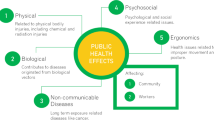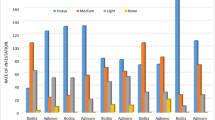Abstract
Aim
In the Ethiopian Rift Valley, 8.5 million people depend on water sources with excessive fluoride. In one rural village, a fluoride-removal community filter was implemented; a personalized reminder was distributed to change people’s behavior and increase the usage of the in-village community filter. During this promotion phase, an alternative fluoride-removal option was installed in a neighboring village.
This study examines psychological factors that explain the differences in preference between the two options and their influence on the usage of the different sources. In addition, the effectiveness of the applied behavior change technique, a personalized reminder, on the use of the in-village community filter was analyzed.
Subject and methods
In a complete longitudinal survey, 180 households, with access to both mitigation options, were interviewed through structured, face-to-face interviews. Logistic regressions were carried out to reveal factors predicting the usage of the two mitigation options and the effect of the implemented behavior change intervention.
Results
The results showed that the better the taste, the lower the effort and the lower the costs for using the in-village community filter are perceived; in addition, the lower the perceived vulnerability to contract disease, the more the in-village community filter is used. Moreover, it was found that the personalized reminder also had a positive effect on the usage of the in-village mitigation option.
Conclusion
Based on the results, possible recommendations for practitioners and researchers are made to help plan and implement mitigation options.


Similar content being viewed by others
Notes
1 ETB (Ethiopian Birr) = 6 US cents (exchange rate on June 13, 2011).
References
Albarracín D, Gillette JC, Earl AN, Glasman LR, Durantini MR, Ho MH (2005) A test of major assumptions about behavior change: a comprehensive look at the effects of passive and active HIV-prevention interventions since the beginning of the epidemic. Psychol Bull 131:856–897
Arnold B, Arana B, Mäusezahl D, Hubbard A, Colford J (2009) Evaluation of a pre-existing, 3-year household water treatment and handwashing intervention in rural Guatemala. Int J Hyg Envir Heal 38:1651–1661
Bem DJ (1972) Self-perception theory, vol 6. Academic, New York
De Young R (1993) Changing behavior and making it stick: the conceptualization and management of conservation behavior. Environ Behav 25:485–505
DeLeon IG, Fuqua RW (1995) The effects of public commitment and group feedback on curbside recycling. Environ Behav 27:233–250
Graffeo M, Savadori L, Tentori K, Bonini N, Rumiati R (2009) Consumer decision in the context of a food hazard: the effect of commitment. Mind Soc 8:59–76
Halder AK, Tronchet C, Akhter S, Bhuiya A, Johnston R, Luby SP (2010) Measures of handwashing behavior and indicators associated with hand hygiene in rural Bangladesh. BMC Publ Health 10:545–553
Holland R, Aarts H, Langendam D (2006) Breaking and creating habits on the working floor: a field-experiment on the power of implementation intentions. J Exp Soc Psychol 42:776–783
Huber AC, Bhend S, Mosler HJ (2011a) Determinants of exclusive consumption of fluoride-free water: a cross-sectional household study in rural Ethiopia. J Public Health 20:269–278. doi:10.1007/s10389-011-0445-z
Huber AC, Tobias R, Mosler HJ (2011) Evidence-based tailoring of persuasion campaigns: increasing fluoride-free water consumption in rural Ethiopia. Paper presented at the 25th Annual Conference of the European Health Psychology Society, Hersonissos, Crete, Greece, September 2011
Inauen J, Mosler H-J (2010) Risky consumption of drinking water: predicting the use of arsenic-safe drinking water options in Bangladesh. Oral presentation at the 27th International Congress of Applied Psychology, Melbourne, Australia, July, 2010
Kiesler CA, Sakumura J (1966) A test of a model for commitment. J Pers Soc Psychol 3:349–353
Kloos H, Tekle-Haimanot R (1999) Distribution of fluoride and fluorosis in Ethiopia and prospects for control. Trop Med Int Health 4:355–364
Korir H, Mueller K, Korir L, Kubai J, Wanja E, Wanjiku N, Waweru J, Mattle MJ, Osterwalder L, Johnson CA (2009) The development of bone char-based filters for the removal of fluoride from drinking water. Paper presented at the 34th WEDC International Conference, Addis Ababa, Ethiopia, May 2009
Krebs R (2002) Anleitung zur Herstellung von MC-Fragen und MC-Prüfungen [Instructions for preparing MC-questions and MC-exams]. http://www.fnl.ch/LOBs/LOs_Public/MC_Anleitung.pdf. Accessed 6 March 2010
Lewis AL, Eves FF (2012) Testing the theory underlying the success of point-of-choice prompts: a multi-component stair climbing intervention. Psychol Sport Exercise 13:126–132
Lichtenstein DR, Ridgway NM, Netemeyer RG (1993) Price perceptions and consumer shopping behavior: a field study. J Marketing Res 30:234–245
McDonagh MS, Whiting PF, Wilson PM, Sutton AJ, Chestnutt I, Cooper J, Misso K, Bradley M, Treasure E, Kleinjnen J (2000) Systematic review of water fluoridation. Br Med J 321:855–859
Monroe KB (1973) Buyers’ subjective perceptions of price. J Marketing Res 10:70–80
Mosler HJ (2012) A systematic approach to behavior change interventions for the water and sanitation sector in developing countries: a conceptual model, a review, and a guideline. Int J Environ Health Res. doi:10.1080/09603123.2011.650156
Mosler HJ, Tobias R (2007) How do commitments work? An agent-based simulation using data from a recycling campaign in Santiago de Cuba. Paper presented at the International Conference on Artificial Intelligence, Las Vegas, NV, June 2007
Mosler HJ, Blöchliger OR, Inauen J (2010) Personal, social, and situational factors influencing the consumption of drinking water from arsenic-safe deep tubewells in Bangladesh. J Environ Manage 91:1316–1323
Petty RE, Rucker DD, Bizer GY, Cacioppo JT (2004) The elaboration likelihood model of persuasion. In: Seiter JS, Gass RH (eds) Perspectives on persuasion, social influence, and compliance gaining. Pearson, Boston, pp 65–90
Smith JR, Terry DJ, Manstead ASR, Louis WR, Kotterman D, Wolfs J (2008) The attitude-behavior relationship in consumer conduct: the role of norms, past behavior, and self-identity. J Soc Psychol 148:311–333
Teillet E, Urbano C, Cordelle S, Schlich P (2009) Consumer perception and preference of bottled and tap water. J Sens Stud 25:463–480
Tekle-Haimanot R, Melaku Z, Kloos H, Reimann C, Fantaye W, Zerihun L, Bjorvatn K (2006) The geographic distribution of fluoride in surface and groundwater in Ethiopia with an emphasis on the Rift Valley. Sci Total Environ 367:182–190
Thyer BA, Geller ES (1987) The “buckle up” dashboard sticker: an effective environmental intervention for safety belt promotion. Environ Behav 19:484–494
Tobias R (2009) Changing behavior by memory aids: a social psychological model of prospective memory and habit development tested with dynamic field data. Psychol Rev 116:408–438
World Health Organization (2004) Guidelines for drinking-water quality, 3rd edn. World Health Organization, Geneva
Acknowledgments
The present study is part of the Water Resource Quality (WRQ) project at EAWAG. First of all, we would like to extend thanks to Tesfaye Edosa, our field research assistant, and Feyisa Lemma, our social worker from the Oromo Self-Help Organization (OSHO). Without their professional input, valuable contribution, and great collaboration during the fieldwork, we would not have been able to accomplish the project. Second, our thanks go to all of our interviewers and health promoters, who contributed significantly to the success of the survey. Finally, we want to name the Swiss National Science Foundation (SNF) and the Swiss Agency for Development and Cooperation (DEZA) as the project’s financial support.
Conflicts of interest
The authors declare that they have no conflict of interest.
Author information
Authors and Affiliations
Corresponding author
Rights and permissions
About this article
Cite this article
Huber, A.C., Mosler, HJ. Determining the differential preferences of users of two fluoride-free water options in rural Ethiopia. J Public Health 21, 183–192 (2013). https://doi.org/10.1007/s10389-012-0537-4
Received:
Accepted:
Published:
Issue Date:
DOI: https://doi.org/10.1007/s10389-012-0537-4




